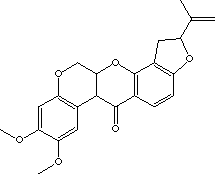Rotenone
- 1,2,12,12a-Tetrahydro-2-alpha-isopropenyl-8,9-dimethoxy(1)benzopyrano(3,4-b)furo(2,3-H)(1)benzopyran-6(6AH)-one
- (2R,6aS,12aS)-1,2,6,6a,12,12a-Hexahydro-2-isopropenyl-8,9-dimethoxychromeno[3,4-b]furo[2,3-h]chromen-6-one

Rotenone | |
| |
| Formula | C23H22O6 |
| Structure |  |
| Description | Colorless to brownish crystals or a white to brownish-white crystalline powder. Has neither odor nor taste. |
| Uses | Control of aphids, thrips, psyllids, moths, beetles, spider mites, etc in fruit and vegetable cultivation. Insecticidal control of premises. Control of fire ants. Control of lice, ticks, and warble flies on animals. Also used to control fish populations in fish management. |
| Registry Numbers and Inventories. | |
| CAS | 83-79-4 |
| EC (EINECS/ELINCS) | 201-501-9 |
| EC Index Number | 650-005-00-2 |
| EC Class | Toxic; Irritant; Dangerous for the Environment |
| RTECS | DJ2800000 |
| RTECS class | Agricultural Chemical and Pesticide; Tumorigen; Mutagen; Reproductive Effector; Human Data; Natural Product; Primary Irritant |
| UN (DOT) | 2922 |
| Merck | 12,8427 |
| Beilstein/Gmelin | 99068 |
| Beilstein Reference | 5-19-10-00581 |
| EPA OPP | 71003 |
| Swiss Giftliste 1 | G-2835 |
| Canada DSL/NDSL | DSL |
| Austrailia AICS | Listed |
| New Zealand | Listed |
| Properties. | |
| Formula | C23H22O6 |
| Formula mass | 394.42 |
| Melting point, °C | 161 |
| Boiling point, °C | 501 |
| Vapor pressure, mmHg | 0.0008 |
| Critical temperature | 693 |
| Critical pressure | 16.5 |
| Density | 1.27 g/cm3 (20 C) |
| Solubility in water | Insoluble |
| Partition coefficient, pKow | 2.90 |
| Hazards and Protection. | |
| Storage | Store in a tightly closed container. Store in a cool, dry, well-ventilated area away from incompatible substances. Do not expose to air. Store protected from light. Store under an inert atmosphere. |
| Handling | Wash thoroughly after handling. Remove contaminated clothing and wash before reuse. Minimize dust generation and accumulation. Do not breathe dust, vapor, mist, or gas. Do not get in eyes, on skin, or on clothing. Do not ingest or inhale. Store protected from light. Handle under an inert atmosphere. Store protected from air. Use only in a chemical fume hood. |
| Protection | Eyes: Wear appropriate protective eyeglasses or chemical safety goggles as described by OSHA's eye and face protection regulations in 29 CFR 1910.133 or European Standard EN166. Skin: Wear appropriate protective gloves to prevent skin exposure. Clothing: Wear appropriate protective clothing to prevent skin exposure. |
| Respirators | A respiratory protection program that meets OSHA's 29 CFR 1910.134 and ANSI Z88.2 requirements or European Standard EN 149 must be followed whenever workplace conditions warrant a respirator's use. |
| Small spills/leaks | Vacuum or sweep up material and place into a suitable disposal container. Avoid generating dusty conditions. Provide ventilation. Place under an inert atmosphere. |
| Stability | Stable under normal temperatures and pressures. |
| Incompatibilities | Strong oxidizing agents, alkalis, air. |
| Decomposition | Carbon monoxide, irritating and toxic fumes and gases, carbon dioxide. |
| Fire. | ||||
| Fire fighting | Wear a self-contained breathing apparatus in pressure-demand, MSHA/NIOSH (approved or equivalent), and full protective gear. During a fire, irritating and highly toxic gases may be generated by thermal decomposition or combustion. Extinguishing media: Use extinguishing media most appropriate for the surrounding fire. In case of fire use water spray, dry chemical, carbon dioxide, or chemical foam. | |||
| Fire potential | This material is probably combustible. | |||
| Hazards | Contact with metals may evolve flammable hydrogen gas. | |||
| Combustion products | Fire may produce irritating, corrosive and/or toxic gases. | |||
| NFPA | Health | 2 | ||
| Flammability | 0 | |||
| Reactivity | 0 | |||
| Health. | |
| Exposure limit(s) | TLV: ppm; 5 mg/m3 (ACGIH 1991-1992). OSHA PEL: TWA 5 mg/m3 NIOSH REL: TWA 5 mg/m3 NIOSH IDLH: 2500 mg/m3 |
| Poison_Class | 3 |
| Exposure effects | Prolonged or repeated skin contact may cause dermatitis. Prolonged or repeated eye contact may cause conjunctivitis. May cause liver and kidney damage. May cause reproductive and fetal effects. Laboratory experiments have resulted in mutagenic effects. Exposure to large doses may cause central nervous system depression. |
| Ingestion | Harmful if swallowed. Ingestion may cause irritation of the digestive tract with abdominal pain, vomiting, diarrhea, numbness of the oral mucous membrane, slow or irregular pulse, incoordination, and muscle tremors |
| Inhalation | Causes respiratory tract irritation. Inhalation of large amounts may cause respiratory stimulation, followed by respiratory depression, convulsions and possible death due to respiratory paralysis. This product is more toxic when inhaled than when ingested. |
| Skin | Causes skin irritation. |
| Eyes | Causes eye irritation. |
First aid | |
| Ingestion | Do NOT induce vomiting. If victim is conscious and alert, give 2-4 cupfuls of milk or water. Never give anything by mouth to an unconscious person. Get medical aid immediately. Wash mouth out with water. |
| Inhalation | Get medical aid immediately. Remove from exposure to fresh air immediately. If breathing is difficult, give oxygen. DO NOT use mouth-to-mouth respiration. If breathing has ceased apply artificial respiration using oxygen and a suitable mechanical device such as a bag and a mask. |
| Skin | Get medical aid. Immediately flush skin with plenty of soap and water for at least 15 minutes while removing contaminated clothing and shoes. Wash clothing before reuse. |
| Eyes | Immediately flush eyes with plenty of water for at least 15 minutes, occasionally lifting the upper and lower eyelids. Get medical aid. |
| Transport. | ||
| UN number | 2922 |  |
| Response guide | 154 | |
| Hazard class | 8 | |
| Packing Group | I; II; III | |
| USCG Compatatibility Group | 18. Ketones | |